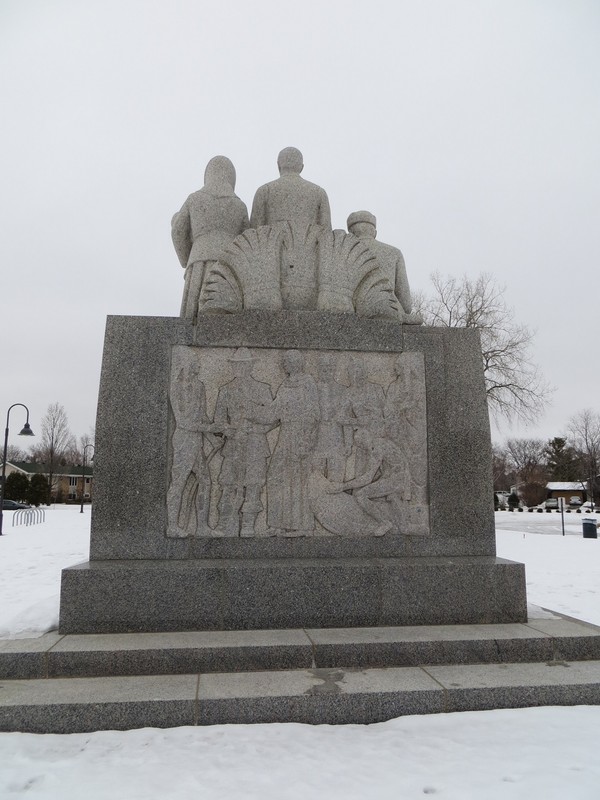The Pioneers
Introduction
Text-to-speech Audio
Granite monument carved by local Norwegian-born sculptor John K. Daniels. Erected as part of a 1930s efforts to replace skid row with an elaborate City Center, this statue was placed in the newly formed Pioneers Park, near the new art deco Post Office. Relocated to Northeast Minneapolis in 1961 amid new urban renewal efforts. It remained on a small traffic island until 2008, when it was moved 100 yards to a newly formed BF Nelson Park. In 2020, amid a growing Black Lives Matter protest movement following the police killing of George Floyd nearby, protesters splashed the monument with red paint and spray-painted anti-colonial slogans onto it.
Screen reader support enabled.
Images
The Pioneers by John K. Daniel

Reverse of The Pioneers

Backstory and Context
Text-to-speech Audio
In the early 1930s, Minneapolis, Minnesota, city leaders pursued an elaborate plan to raze a red-light district and construct a new Civic Center inspired by the City Beautiful movement to include a parklike square to be renamed “Pioneer Square.” Minneapolis Park Superintendent Theodore Wirth originally envisioned a tall stone shaft topped by a bronze American eagle and surrounded at its base by four bronze figures at its base: a Native man and woman, and a pioneer man and woman.
In contrast, local sculptor John K. Daniels envisioned a granite or bronze design emphasizing White industry and economic development in the Mill City: a 25-foot-tall base representing 2 millstones on top of each other, above which an overshot water wheel would tower. A pioneer and a laborer would stand to either side of the water wheel. At the top of a pedestal would be a young woman representing Minnesota, holding a sheaf of wheat to celebrate the city’s flour milling industry.
Those two different views ultimately yielded to a monument that closely resembled other Midwestern pioneer monuments’ representations of early settlers. It emphasized a hard-working male Anglo-American settler, supported by a self-sacrificing wife and mother, and accompanied by a frontiersman who might represent other European immigrant groups and perhaps also the laborers that Daniels originally proposed.
On the reverse of the monument is a bas relief that portrays French missionaries/explorers paving the way for White settlement. Daniels’ bas relief celebrated the man credited with “discovering” the falls of the Mississippi River. Known to the Dakota as Owámniyomni, among other names, Louis Hennepin renamed the falls after his patron saint. Those falls later provided the power that enabled Minneapolis to grow into the wheat milling capital of the region. Daniels’ relief portrayed a European Catholic missionary interactive with the local Native population.
Three decades later, a massive freeway construction project spurred another effort at redevelopment. An apartment tower was constructed on the site of Pioneer Park; the 14-ton granite monument was moved to a “temporary” location in the St. Anthony West neighborhood on a tiny triangle of land beside a split-level home, where it served as a bumper to automobile traffic more than a public monument. After languishing in that location for another forty years, a local neighborhood association raised funds to move the statue across Main Street to the newly created B. F. Nelson Park.
The monument received little public attention in its new permanent location until Black Lives Matter and anti-colonialism protests swept the nation in the wake of the police killing of George Floyd about 5 miles from the monument in May 2020. The Minneapolis Park and Recreation Board received complaints about the statue. On Thanksgiving morning 2020–a holiday that some have renamed a National Day of Mourning to mark the devastating impact of white colonization on Native peoples–someone splashed the monument with red paint. They spray-painted anti-colonial slogans on the granite monument: “no thanks,” “no more genocide,” “Decolonize,” and “land back.”
Sources
Prescott, Cynthia Culver. Pioneer Mother Monuments: Constructing Cultural Memory. Norman, Oklahoma. University of Oklahoma Press, 2019.
Prescott, Cynthia Culver. The Pioneers, Minneapolis, MN, Pioneer Monuments in the American West. January 22nd 2022. Accessed January 22nd 2022. https://pioneermonuments.net/the-pioneers-minneapolis-mn/.
Sawyer, Liz and Tim Harlow. "Vandals hit Minneapolis statues of George Washington and Pioneers." Star Tribune (Minneapolis) November 27th 2020.
Pioneer Monuments in the American West
Pioneer Monuments in the American West
